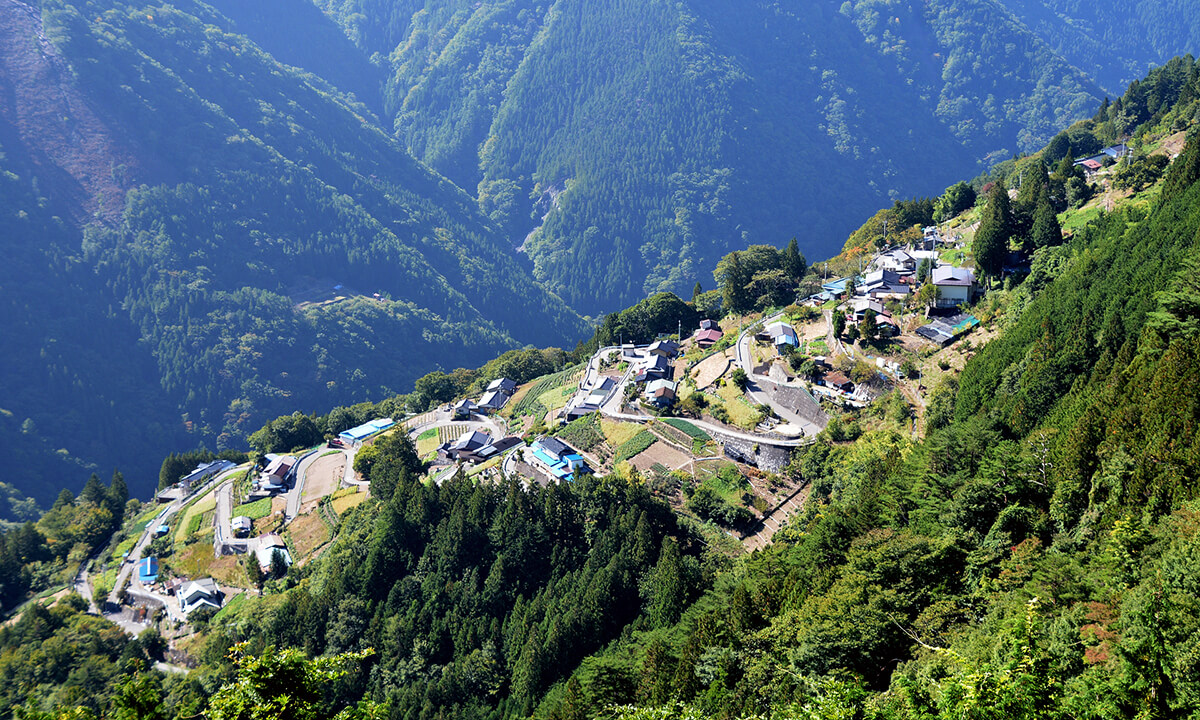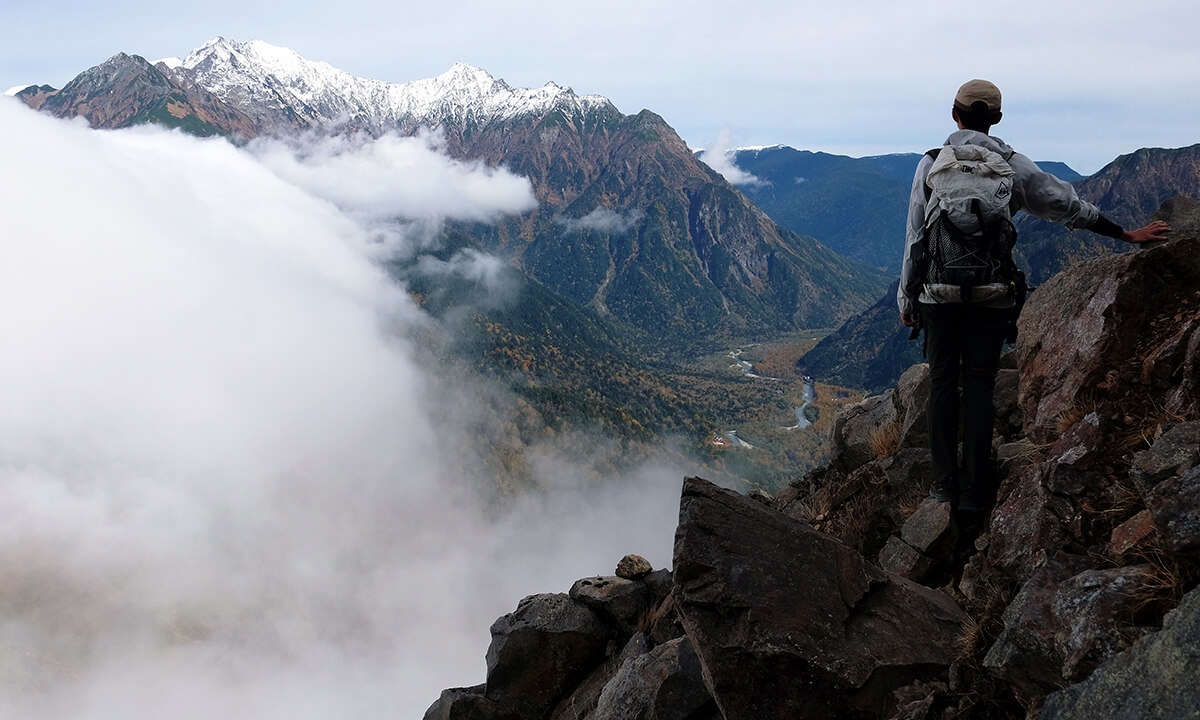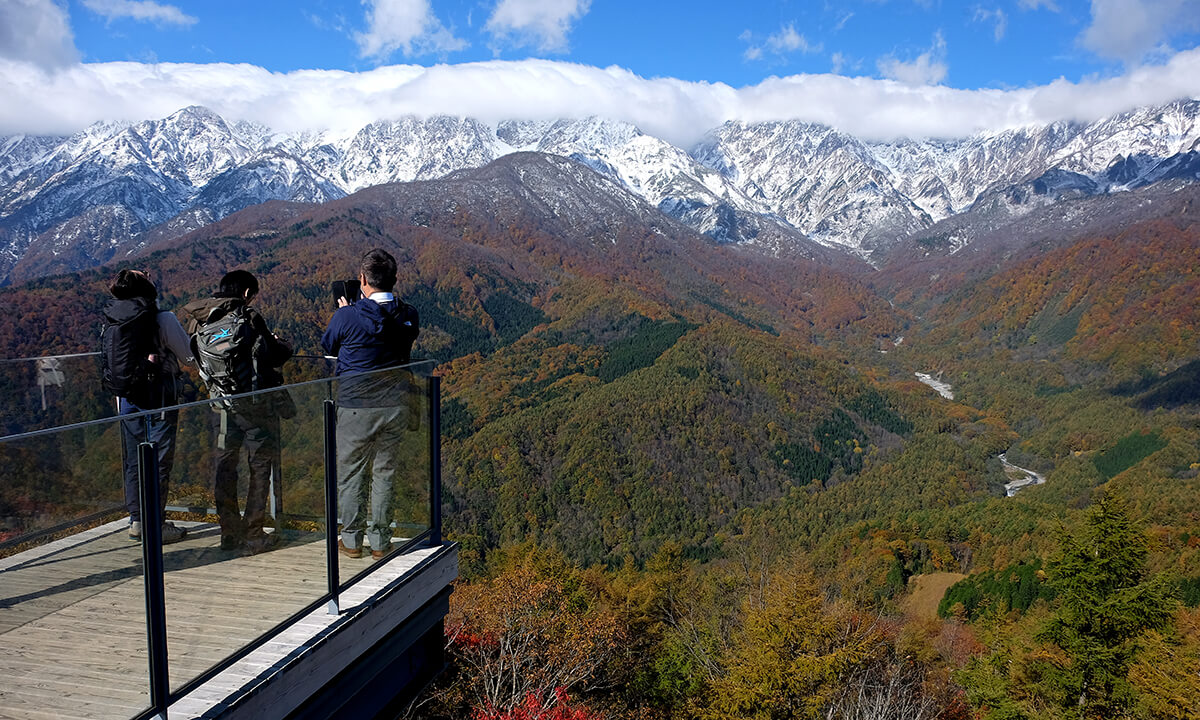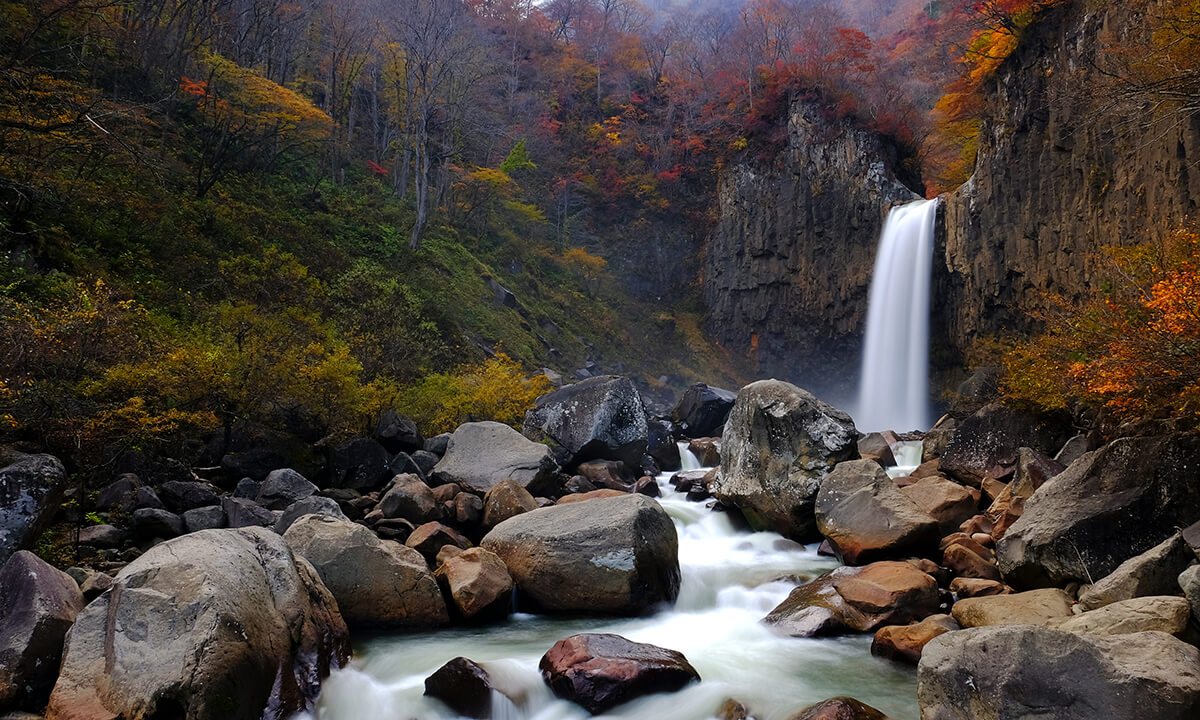|
Centrip Editorial Board
Nine of Nagano's Top Natural Places and Scenic Views

Nagano Prefecture features some of the most superlative topography and scenic spots, including rugged mountains, abundant, clear rivers, dense forests, and traditional landscapes. In this article, we'll introduce nine locations that perfectly highlight the variety of beautiful natural places and striking views just waiting to be discovered throughout Nagano.
Senjojiki Cirque
Glacier-carved valley home to one of the country's most iconic alpine views
 Beautiful autumn colors spread across the Senjojiki Cirque
Beautiful autumn colors spread across the Senjojiki Cirque
The Senjojiki Cirque is a vast, amphitheater-shaped plain carved into the mountains by glacial activity millennia ago. Today it is an alpine paradise that lets you experience the grandeur of the Japanese Alps and witness the full majesty of the four seasons while immersed in incredible natural surroundings.
Highlights
Senjojiki sits at an elevation that's often the exclusive domain of experienced alpinists and reachable only after hours of hard climbing. However, the Komagatake Ropeway stands ready to whisk ordinary sightseers and hobby hikers to the base of the cirque, both sweat, and stress-free. Disembarking from the ropeway station is like stepping into another, exotic world above the clouds. The altitude seems to amplify the magnificence every season, with fields of endless alpine flowers blooming in summer (late June to August), a wave of gold and crimson hues breaking across the mountainside in fall (late September to October), the stark, silent beauty of ice, snow, and rock in winter and the spring snowmelt slowly revealing the mountain's muted canvas before it bursts forth into color once more.
Hiking around the base of the cirque to capture the panoramic views and seasonal wonders on camera is perhaps the most popular activity. There's an easy 1-hour loop
walk starting at and returning to the ropeway station that gives you ample opportunity to pad your Instagram stream. Overnight stays are possible at the Hotel Senjojiki, located immediately next to the ropeway terminus. If you stay overnight, be sure to glance heavenward: the night sky is brilliant here and is often punctuated by a visible Milky Way.
Shimoguri-no-Sato
A secluded hillside settlement suspended in the sky
 Shimoguri-no-Sato from the ‘Tenku-no-Sato' (Sky Village) viewpoint
Shimoguri-no-Sato from the ‘Tenku-no-Sato' (Sky Village) viewpoint
Shimoguri-no-Sato is an isolated hillside hamlet of fewer than 50 households that is recognized for its singular beauty. The settlement ranges in elevation from 800 to 1,100 meters above sea level and clings to slopes angled at almost 40 degrees in places surrounded by soaring mountains. For visitors, it presents the opportunity to encounter both a rare and remarkable landscape as well as a traditional lifestyle that transports you to another time and place.
Highlights
The best vantage point to capture the uniquely scenic village from is the ‘Tenku-no-Sato Viewpoint’. This small observation deck provides the ultimate bird’s-eye view of the settlement and its sensational surroundings. From this angle, Shimoguri-no-Sato appears to almost be floating amongst the mountains, and the feeling is even more pronounced on mornings where a sea of clouds hovers below it. A stroll through the village is a great way to observe and learn about some of the community's unique agricultural practices, rich culture, and simple way of life on display; just be sure to remain respectful since you are a visitor, and these are people’s homes. If you’d like the opportunity to interact with locals or are feeling hungry, stop at Hanbatei, the only eatery in town. The staff is comprised entirely of residents and their food is made from locally grown ingredients using traditional recipes. Lodging can be booked at several local guesthouses.
Shimoguri-no-Sato is accessible 365 days per year, but the Hanbatei restaurant is closed on Thursdays and shuts down for the winter between late November and mid-April.
Kamikochi
A pristine valley, aptly known as 'The Jewel of the Japanese Alps'
 A bird's-eye view of the Kamikochi valley from Mt. Yake
A bird's-eye view of the Kamikochi valley from Mt. Yake
Kamikochi is a place of awe-inspiring beauty that showcases the true richness of Japan's wild places. The sublime valley sits at the foot of the hulking Hotaka Range of mountains and snakes alongside the turquoise blue waters of the Azusa River through unspoiled forests for nearly 18 kilometers. At 1,500m of elevation and far removed from busy population centers, it's an ideal environment to refresh your mind and body and reconnect with nature.
Highlights
Exploring Kamikochi on foot is a must to get the full picture of all it has to offer. If you only have a few hours, it's best to stick to the well-marked trails that head to the famous Kappa Bridge, through the Konashidaira Campground, and on to Myojin Pond before looping around on the other side of the river back to Kappa Bridge. This 8-kilometer walk takes you to the most easily accessible points of interest, through beautiful forests and along the crystal-clear waters of the Azusa River. If you have a little more time, try heading back in the opposite direction towards the Taisho Pond: it's a favorite spot of photographers looking to shoot the mountains reflected in its placid waters.
Kamikochi's official opening season is from April 27th to November 15th. Late May to early June is the peak season for fresh spring greenery, alpine flowers climax during July and August, and October is your best bet for fall colors. Visiting in winter is possible, but you'll have to hike (snowshoe) in and be entirely self-sufficient.
Kurobe Dam: Tateyama Kurobe Alpine Route
A massive man-made wonder surrounded by exceptional natural beauty
 Kurobe Dam and the vibrant summer greenery of early August
Kurobe Dam and the vibrant summer greenery of early August
The fabled Kurobe Dam is a marvel of engineering and effort that was completed in 1963, after 7 years of intense labor fraught with struggles. Portions of the Tateyama Kurobe Alpine Route were originally built to aid in ferrying supplies required for the dam's construction and only later repurposed and expanded into their current form. Today the dam is accessed by the Alpine Route and stands as a symbol of Japanese ingenuity and perseverance in addition to being an impressive concrete colossus set amongst a dramatic landscape.
Highlights
The size of the Kurobe Dam is overwhelming, but the stories behind its development loom even larger than its imposing form. It was put together at an enormous cost, both financially and physically with more than 51 billion yen and some 10 million workers!
Knowing the scale of the endeavor lends a valuable perspective to the epic views of the dam. Kurobe Lake, the huge reservoir of blue-green water created by the dam, is breathtaking in its own right. To get the full range of views, be sure to head to both the lower and upper observation areas. In most cases, an hour or two is plenty if you just want to see the dam and take a few photos. If you aren't on an ultra-tight schedule, spend a full day in the area and indulge in a few more activities near the dam. These include an easy 1-hour walk along the western bank of Kurobe Lake to the Kuroyon hut and back that takes you over a large suspension bridge and into a beautiful birch/beech forest or a 30-minute pleasure cruise on the lake (from June to mid-November).
Access to the dam is possible using the Alpine Route between mid-April and the end of November. The daily water discharges from the dam occurring between 6/26 and 10/15 are a powerful display that has become a crowd favorite. 10 tons of water per second gush forth from valves set high into the concrete walls, creating glorious rainbows against the tremendous plumes of steam.
Tsugaike Nature Park
A natural paradise above the clouds with unbeatable mountain views
 A view of 2,932-meter Mt. Shirouma from Tsugaike Nature Park in late June
A view of 2,932-meter Mt. Shirouma from Tsugaike Nature Park in late June
Tsugaike's beloved natural park is a specifically protected nature preserve that encompasses over 100 hectares of untouched wilderness. A journey through the park's 5.5-kilometer trails will take you past several marshes and viewpoints, each with its unique alpine flora. The Northern Alps' peaks, soaring 1,000 meters directly above the Nature Park, complete the picture-perfect backdrop for your visit.
Highlights
The park is the ideal place to observe the seasonal shifts since the progression of alpine plants in this harsh environment is beautifully synchronized with the calendar. Winter is long, dark, and cold, with up to 6 meters of snow, but as temperatures warm and daylight hours slowly increase during the spring, the snowmelt fosters the growth of Mizubasho or Asian Skunk Cabbage. These vast fields of white flowering Mizubasho peak in early to mid-June and herald the arrival of the green season.
The nature park is roughly divided in two by the Kusu River. Those with limited time can stick to the wooden boardwalks on the eastern side that circle the Mizubasho and Watasuge marshes. A full loop of this side of the park is around 2 kilometers and takes about 1.5 hours. Crossing the river and heading deeper into the park you’ll find the Ukishima and Tenbo marshes. This point has incredible, unobstructed views of Hakuba's three major peaks as well as the famed Hakuba Daisekkei: a deep V-shaped valley that retains snow year-round. To get to the Tenbo you're looking at a 5.5-kilometer hike that takes about 3.5 hours to complete. It's also possible to stay overnight at either of the two lodges sitting just outside the gates of the nature park: Tsugaike Sanso or Tsugaike Hyutte.
Hakuba Mountain Harbor
A superb-scenic terrace with a legendary New York City bakery
 Visitors enjoy the view from the Mountain Harbor terrace
Visitors enjoy the view from the Mountain Harbor terrace
Hakuba Mountain Harbor is a modern wood and glass terrace extending out over the summit of a 1,300-meter peak, built for taking in the superb views of the majestic Northern Alps, which lie directly across the valley. It's also home to an on-deck bakery serving up fresh coffee and sweets as well as sandwiches, soups, and even draft beer. It is a favorite of locals and tourists alike since opening in the fall of 2018.
Highlights
Hakuba Mountain Harbor can confidently claim the title of Hakuba's Best Viewpoint. The terrace itself is propped up by pillars that make it feel as if it's hovering in space over the hillside below, and the unspoiled scenery seems to go on forever in all directions. But it's the combination of a superbly-scenic terrace with a tasty bakery that sets it apart. The bakery is a satellite store of The City Bakery, an iconic NYC institution that got its start in Manhattan in the early 1990s, before expanding with several locations in Japan beginning in 2013.
The views from Hakuba Mountain Harbor are compelling throughout all four seasons, but Iwatake prides itself on being the best place to experience what they call sandan koyo. This translates to '3-tiered fall leaves,' and refers to the phenomenon where the base areas of the mountains are still green, the leaves midmountain are at peak autumn colors and the tops of the Alps are white with fresh snowfall. It’s hard to express the satisfaction of enjoying such fantastic views on a crisp autumn morning with a steaming cup of hot coffee and a chocolate chunk cookie in hand.
If you want to combine your visit with some skiing in winter or any of the dozens of other adventure or family-oriented activities available in summer, you can make a full day out of it.
Togakushi Shrine and Kagami Pond
A sacred shrine set amongst stunning natural scenery
 400-year-old trees and the beautiful red Zuishinmon gate
400-year-old trees and the beautiful red Zuishinmon gate
The name Togakushi can refer to Mt. Togakushi, the jagged spine of rock overlooking the area, or the village itself, but it is most synonymous with the sacred shrines scattered across its forests. These shrines, composed of five main buildings arranged into three complexes, are collectively known as Togakushi Shrine. Togakushi Shrine is one of Japan's most important spiritual sites and has a long and fascinating history that goes back as far as 2,000 years and involves one of the most well-known incidents of ancient Japanese mythology. Aside from the shrine's elevated status and stirring origin story, it is a strikingly picturesque place that buzzes with powerful energy.
Highlights
Visitors will surely want to prioritize a stop at the most important of Togakushi's shrines, the upper shrine, or Okusha. The buildings are fairly average in size and appearance, but the 2-kilometer walk to the shrine via the main path leading from the road and bus stop is an absolute show-stealer. Around the halfway point stands a beautiful, bright-red gate called Zuishinmon, and the trail in the gate's vicinity is lined on both sides with hundreds of gigantic Japanese cedar trees said to be 400-plus years old. It's hard not to feel awe and reverence for nature while walking through this grand, green corridor. The whole scene lends a divine aura to the approach that leaves a strong and lasting impression. An excellent way to cap off your visit to the upper shrine is with another scenic walk through the forest to the stunning and oft-photographed Kagami Pond. The name translates to 'mirror pond', which aptly describes how the waters on calm, windless days can perfectly mirror the surrounding scenery, chiefly the towering walls of Mt. Togakushi and the dense forest at its base.
Togakushi can be visited year-round, but the area can receive heavy snowfall in winter and some spots, particularly Okusha, can be difficult or impossible to access without snowshoes.
Mt. Nagamine Summit
A pleasant peak with a commanding panorama of Azumino and the Alps
 Alpenglow across the Northern Alps and Azumino at sunrise, as seen from Mt. Nagamine
Alpenglow across the Northern Alps and Azumino at sunrise, as seen from Mt. Nagamine
In a landscape where most eyes are immediately drawn west to the exquisitely- exaggerated topography of the Northern Alps, and later to the lush green plains spreading out before them, the lesser mountains to the east can be easily overlooked. But those humble hills are home to a hidden gem, a spectacular spot known to locals for its unparalleled panoramic views: 933-meter Mt. Nagamine.
Highlights
The undisputed highlight of any trip to Mt. Nagamine is gazing out over its supremely beautiful scenery; rivers, rice fields, and residences dot the plains directly below, butting up against a solid wall of mountains towering before you. Although the mountain is mostly forested, the summit area is a tree-free patch of manicured grass with a large art installation and a raised gazebo/viewing deck. The grassy slope extends down slightly to a wooden runway used by local paragliders to launch themselves out over Azumino when conditions are suitable, and the grass is great for picnicking and for letting pets and children play.
Mt. Nagamine is nice as a sunset spot, since the view faces west, and you can watch the sun as it slowly sets behind the Alps. It can also be fantastic for watching the tops of the mountains glow red with alpenglow during the sunrise. And don’t forget the sea of clouds and city lights at night. All in all, there's never really a bad time to visit.
Mid to late April is the best time to go since you can combine the beauty of the mountain’s many cherry blossoms with the still snow-capped Alps across the valley.
Shinanomachi Forest Therapy
A beautiful environment at the epicenter of the forest therapy movement
 Naena Falls are part of Shinanomachi's 1-day forest therapy 'Fitness' course
Naena Falls are part of Shinanomachi's 1-day forest therapy 'Fitness' course
Shinanomachi is home to several natural features that serve as representatives of the area’s scenic beauty, including the volcanic highlands of Kurohime Kogen (plateau), the mighty Naena Waterfall, and the expansive Lake Nojiri. The splendor of these places has drawn visitors, writers, thinkers, and settlers to the area for centuries. But Shinanomachi is also home to beautiful old-growth forests and their proven powers to heal.
Highlights
Contrary to the image some have of Japan as an island full of densely populated megacities, this is a country of mountains and forests. Even in a day and age of rampant deforestation, two-thirds of the landmass here is still draped in woodlands, more than twice the global average. Japan’s connection to and appreciation of its natural lands runs deep and nowhere is this more apparent than in the small town of Shinanomachi. Shinanomachi’s beautiful, diverse and balanced forests have been extremely influential in the study and development of the ‘forest bathing’ or ‘forest therapy’ phenomenon that is now sweeping the globe.
Forest therapy centers around the power to simultaneously awaken our senses and relax our mind and bodies, alleviating stress, reducing pain and fatigue, and improving overall health in the process. Shinanomachi’s rich forests have been used extensively as a base for the scientific studies into these rejuvenating effects, and many of the guiding principles and now-standard practices and techniques used in forest therapy have been pioneered here as a result. There simply is no better place to give forest therapy a try.
Shinanomachi offers several different small groups or one-on-one guided courses in both English and Japanese under their 'Iyashi no Mori', or 'healing forest' program, ranging from a half to a full day and including a variety of different therapies.
Forest therapy is available throughout the year, and during the winter months is often conducted on snowshoes. The town is also happy to help you decide on a course that is appropriate for your goals, the season, and the weather conditions.
Click here to get the latest information on Central Japan.Centrip Japan - Nagoya and Chubu Information

